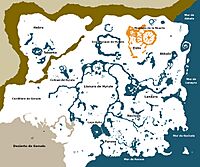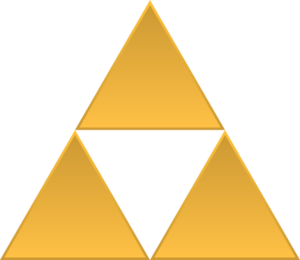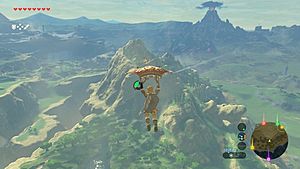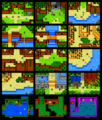The Legend of Zelda facts for kids
Quick facts for kids The Legend of Zelda |
|
|---|---|
 |
|
| Genre | Action-adventure |
| Developers |
|
| Publisher | Nintendo |
| Creators | |
| Producer | Eiji Aonuma |
| Artist | Takaya Imamura |
| Writer | Kensuke Tanabe |
| Composer | Koji Kondo |
| Platforms | |
| First release | The Legend of Zelda February 21, 1986 |
| Latest release | The Legend of Zelda: Tears of the Kingdom May 12, 2023 |
| Spin-offs | List of spin-offs |
The Legend of Zelda is a super popular action-adventure game series. It was created by Japanese game designers Shigeru Miyamoto and Takashi Tezuka. Most of the games are made by Nintendo.
The series is all about a brave young hero named Link. He is an elf-like person from the Hylian race. He teams up with Princess Zelda, a magical princess. They fight to save the magical land of Hyrule. Their main enemy is Ganon, an evil warlord who becomes a demon king. Ganon wants to use the Triforce. This is a special relic left by three goddesses who created Hyrule. He wants to use its power to make the world dark.
The Triforce can grant any wish. But if someone with an unbalanced heart touches it, it splits into three pieces. These pieces go to people who show great Power, Courage, or Wisdom. Link and Zelda change a bit in each game. But Link is often left-handed and wears green. Zelda is usually wise and connected to light. While Ganon is the main bad guy, some games have Link travel to other lands to fight different enemies.
The first Legend of Zelda game came out in 1986. Since then, there have been 20 main games on all of Nintendo's consoles. There are also many spin-off games. An animated TV show based on the games aired in 1989. Manga comics have also been made since 1997. The Legend of Zelda is one of Nintendo's most successful series. Many of its games are thought to be among the greatest video games of all time.
Contents
How to Play the Game
The Legend of Zelda games mix puzzles, action, adventure, and exploration. These parts have stayed the same over the years. But each new game adds cool new things. Later games even include stealth, where you sneak past enemies. There are also racing parts! You can finish the games by just doing the main story. But if you explore and do side quests, you often get helpful items or new powers.
Some items appear in many games. These include bombs to blow up walls and boomerangs to stun enemies. You also find keys for locked doors, magic swords, shields, and bows and arrows. Other items are only in one specific game. The games have some role-playing parts. But they focus more on exciting sword fights than on turn-based battles. The series has greatly influenced action role-playing games. But the creator, Shigeru Miyamoto, calls Zelda a "real-time adventure game." He wants players to feel like they are truly living the adventure.
Every main Zelda game has three main areas. There's a big overworld that connects everything. You can move in any direction, giving you freedom to explore. Then there are towns and cities where you meet other characters. Here you can get special items, advice, or buy equipment. You can also complete side quests. Finally, there are dungeons. These are like mazes, usually underground. They are full of tough enemies, bosses, and important items.
Each dungeon usually has one main item. This item is key to solving puzzles in that dungeon. It also helps you beat the boss and move forward in the game. In almost every Zelda game, you find a map to see the dungeon layout. A magic compass shows where important items are. Later games also have a "big key." This key unlocks the boss door and a special item chest.
In most Zelda games, your health is shown by a line of hearts. Each heart usually means two hit points. You start with three hearts. But you can get more by finding "Heart Containers." You usually get a full Heart Container after beating a dungeon boss. Smaller "Pieces of Heart" are found by doing side quests or exploring. You need a certain number (usually four) to make a full heart container. You can get health back by picking up hearts from defeated enemies. You can also eat food, drink potions, or visit a Great Fairy Fountain. Sometimes you find fairies that can heal you or revive you if you lose all your health.
Zelda games were pioneers in many ways. The first Legend of Zelda was the first console game with a save function. This let players stop and continue their game later. The Legend of Zelda: Ocarina of Time added a targeting system. This helped players lock onto enemies in 3D battles.
Where the Ideas Came From

The main ideas for The Legend of Zelda came from Shigeru Miyamoto's childhood. He loved exploring the hills, forests, and caves around his home in Sonobe, Japan. He once found a cave entrance in the woods. He bravely went inside and explored it with a lantern. Miyamoto says he wanted to create a "miniature garden" for players to explore in each Zelda game.
The story and setting were created by Takashi Tezuka. He wanted to make a fairytale adventure. So, he got ideas from fantasy books like J. R. R. Tolkien's The Lord of the Rings. The Master Sword, a famous weapon in the series, is like the legendary sword Excalibur from the King Arthur stories. Even Link's horse, Epona, got her name from a Celtic goddess.
Miyamoto heard about the American writer Zelda Fitzgerald. He thought her name sounded "pleasant and important." So, he named the princess after her. Link and the fairy were inspired by Peter Pan and Tinker Bell. When the games moved to 3D, the fighting style in Ocarina of Time was based on Japanese samurai sword fighting.
Sounds and Music

Music is a big part of The Legend of Zelda games. You often use musical instruments to solve puzzles. Playing an instrument can trigger events in the game. For example, in the first Zelda game, a recorder can show secret areas. It can also warp Link to dungeon entrances. This idea of warping with music is also in A Link to the Past and Link's Awakening.
In Ocarina of Time, playing instruments is a main part of the game. You use the game controller to play songs. This game was one of the first to make music-making part of the gameplay. You need to play songs to move forward in the game. This is also true in Majora's Mask.
The famous "Legend of Zelda Theme" music was made for the first game. The composer, Koji Kondo, first wanted to use a different song. But he found out it was still copyrighted. So, he wrote the "Zelda Theme" in just one day! This theme is now one of the most famous video game songs ever.
Until Breath of the Wild, Zelda games did not use voice acting for characters. They used written words instead. The series producer, Eiji Aonuma, said that since Link doesn't speak, it would feel strange if other characters did. In Breath of the Wild, you hear natural sounds around you. There is also calm piano music instead of big theme songs for different places.
The Story of Hyrule
The World of Hyrule
The Legend of Zelda mostly takes place in a fantasy world called Hyrule. It looks a lot like medieval Europe. Hyrule has a long history and many different places. We learn about Hyrule's creation in games like A Link to the Past and Ocarina of Time. The main people in Hyrule are the Hylians. They are human-like with pointy ears. Link and Princess Zelda are Hylians.
Some games happen in different lands with their own stories. For example, Hytopia is a connected kingdom. Labrynna and Holodrum are separate countries. Termina and Lorule are like parallel worlds. Koholint is a faraway island that seems to be part of a dream.
The Main Story
The story says that the world of Hyrule was made by three golden goddesses: Din, Farore, and Nayru. Before they left, they left behind a special item called the Triforce. This relic could grant wishes. It looks like three golden triangles. Each triangle stands for one of the goddesses' powers: Power, Courage, and Wisdom.
The Triforce grants any wish, good or bad. So, it was put in a special place called the "Sacred Realm." Only someone with a balanced heart, showing Power, Wisdom, and Courage, could get the whole Triforce. If someone with an unbalanced heart touches it, the Triforce splits. The part that matches their strongest virtue stays with them. The other parts go to other people. The Sacred Realm itself changes based on who enters it. A good person makes it a paradise, but an evil person turns it dark.
In Skyward Sword, an evil being called Demise wanted the Triforce. He fought against the goddess Hylia, who protected it. Hylia sealed Demise away. To keep her people safe, she put them on a floating island called Skyloft. She also planned for a hero to defeat Demise for good. She created the Goddess Sword (which later became the Master Sword). She also gave up her goddess powers to be reborn as a Hylian.
Later, Zelda and Link (who were the reborn Hylia and her chosen hero) defeated Demise. But Demise swore that his anger would return forever. This prophecy came true in Ocarina of Time. Ganondorf tried to get the Triforce, but it split. He got the Triforce of Power. The Triforce of Wisdom went to the princesses named Zelda. The Triforce of Courage went to a young hero named Link in each generation.
The Triforces of Power and Wisdom have been in the series since the first game. But the Triforce of Courage was first seen in Zelda II: The Adventure of Link. Sometimes, the Triforce pieces are scattered. In The Wind Waker, Link has to find all the pieces of the Triforce of Courage. In the first Legend of Zelda, Zelda even broke her Triforce of Wisdom into 8 pieces for Link to find.
The Story Order
|
||
| The Hero is Defeated | The Hero is Victorious | |
|---|---|---|
| Child Era | Adult Era | |
For a long time, fans argued about the order of the Legend of Zelda games. Then, an official timeline was released in a book called Hyrule Historia in 2011. Before that, only a few people at Nintendo knew the secret order.
The timeline shows that after Ocarina of Time, the story splits into three different paths.
- In one path, Link fails to defeat Ganon. This leads to games like A Link to the Past and the original The Legend of Zelda.
- In the other two paths, Link wins. One path follows Link's childhood, leading to games like Majora's Mask and Twilight Princess.
- The third path follows Link's adult life, leading to games like Wind Waker and Spirit Tracks.
More recently, Breath of the Wild and Tears of the Kingdom were placed after all previous games. Nintendo decided not to say which timeline branch they belong to. This lets players imagine the connection themselves.
Main Characters
Link: The Hero of Courage
Link is the main hero of The Legend of Zelda series. He is usually a young Hylian male. He wears a green tunic and a pointed cap. He also carries the Triforce of Courage. In most games, you can name Link yourself. Other characters in the game will then call him by that name.
The creator, Miyamoto, named him "Link" because he is the "link" between the player and the game world. Each Link in the series has a special title. Some examples are "Hero of Time" or "Hero of the Winds." Link doesn't speak in the games. He only makes grunts or yells. This is so you, the player, can imagine what he would say.
Princess Zelda: The Wise Princess
Princess Zelda is the princess of Hyrule. She protects the Triforce of Wisdom. Many princesses in her family are also named Zelda. Most games have Link saving Zelda from Ganon. But sometimes, she helps Link in battles. She uses magic and weapons like Light Arrows.
Zelda sometimes uses other names or disguises. For example, she is known as Sheik in Ocarina of Time. She is also Tetra in The Wind Waker. In Skyward Sword, we learn that the Zelda in that game is a reborn goddess. Her power flows through the royal family. The name "Zelda" comes from the American writer Zelda Fitzgerald.
Ganon: The Evil King
Ganon, also known as Ganondorf in his human form, is the main bad guy in most The Legend of Zelda games. Ganondorf is the leader of a group of desert people called the Gerudo. This group is all female, except for one man born every hundred years. He is much taller than other people. He often looks like a monstrous boar.
His goals change a bit in each game. But usually, he wants to kidnap Princess Zelda. He also wants to take over Hyrule and the world. To do this, he seeks the Triforce. He often has the Triforce of Power, which makes him super strong. But he usually needs the other Triforce pieces to get what he wants. Unlike Link and Zelda, Ganon is usually the same person in every game. The game Skyward Sword says that Ganon is a rebirth of an evil god called Demise.
Game Development Over the Years
| 1986 | The Legend of Zelda |
|---|---|
| 1987 | The Adventure of Link |
| 1988 | |
| 1989 | |
| 1990 | |
| 1991 | A Link to the Past |
| 1992 | |
| 1993 | Link's Awakening |
| 1994 | |
| 1995 | |
| 1996 | |
| 1997 | |
| 1998 | Ocarina of Time |
| Link's Awakening DX | |
| 1999 | |
| 2000 | Majora's Mask |
| 2001 | Oracle of Seasons and Oracle of Ages |
| 2002 | Four Swords |
| The Wind Waker | |
| 2003 | |
| 2004 | Four Swords Adventures |
| The Minish Cap | |
| 2005 | |
| 2006 | Twilight Princess |
| 2007 | Phantom Hourglass |
| 2008 | |
| 2009 | Spirit Tracks |
| 2010 | |
| 2011 | Ocarina of Time 3D |
| Skyward Sword | |
| 2012 | |
| 2013 | The Wind Waker HD |
| A Link Between Worlds | |
| 2014 | |
| 2015 | Majora's Mask 3D |
| Tri Force Heroes | |
| 2016 | Twilight Princess HD |
| 2017 | Breath of the Wild |
| 2018 | |
| 2019 | Link's Awakening |
| 2020 | |
| 2021 | Skyward Sword HD |
| 2022 | |
| 2023 | Tears of the Kingdom |
Early 2D Games (1986–1997)

The first game, The Legend of Zelda, came out in Japan in 1986. It was for the Famicom Disk System. A version for the Nintendo Entertainment System came out in the US in 1987. This game had an "open world" where you could explore freely. It also had a "Second Quest" for more challenge after you beat the game.
The second game, Zelda II: The Adventure of Link, came out in 1987. This game was different. It used a side-scrolling view for battles. It also added experience points like in RPG games. The first two Zelda games were released in cool gold-colored cartridges.
Four years later, A Link to the Past came out in 1991. It went back to the top-down view. It also added the idea of a "Dark World," a parallel dimension. This game was released for the Super NES.
Link's Awakening was the first Zelda game for a handheld system, the Game Boy. It came out in 1993. This game was special because it was the first one not set in Hyrule. Princess Zelda was not in it either! A color version, Link's Awakening DX, came out in 1998 for the Game Boy Color. A new HD remake of Link's Awakening was released for the Nintendo Switch in 2019.
Moving to 3D (1998–2001)
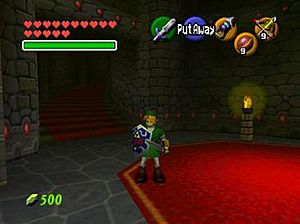
After five years, the series moved to 3D with Ocarina of Time. It came out in 1998 for the Nintendo 64. This game kept the fun gameplay of the older games. It was a huge success! Many people think it's one of the best video games ever.
Ocarina of Time introduced a new way to fight. You could "lock on" to an enemy. This made 3D combat much easier. The game also used one button for many actions. For example, pressing 'A' could make Link grab a block or climb it. This game also introduced Link's horse, Epona. She helped Link travel fast and shoot arrows while riding.
The next game, Majora's Mask, came out in 2000. It used the same 3D graphics as Ocarina of Time. But it added a unique time-based idea. Link had to relive three days over and over to save the world. Link could also use masks to turn into different creatures with special powers. Majora's Mask had a darker mood than other Zelda games. It felt like doom was coming as a giant moon slowly fell towards the land of Termina.
Oracle of Seasons and Oracle of Ages came out at the same time in 2001 for the Game Boy Color. These two games could connect using passwords or a Game Link Cable. If you finished one game, you got a password to play the other as a sequel. Oracle of Ages focused more on puzzles, while Oracle of Seasons had more action.
Toon Link and Multiplayer (2002–2005)
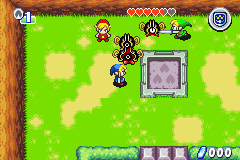
In 2002, the Game Boy Advance version of A Link to the Past included a new game called Four Swords. This was the first Zelda game you could play with friends! It also introduced a new cartoon art style for Link, often called "Toon Link."
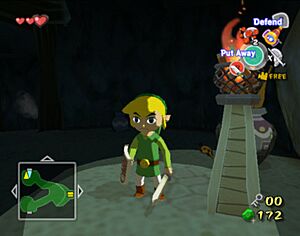
In 2002, Nintendo released The Wind Waker for the GameCube. This game used a unique cartoon-like art style called cel shading. The gameplay focused on controlling the wind with a baton called the "Wind Waker." You also sailed a small boat across an ocean full of islands.
Four Swords Adventures came out in 2004 for the GameCube. It was another multiplayer Zelda game. It focused on playing through levels with friends. To play multiplayer, each person needed a Game Boy Advance linked to the GameCube.
In 2004, The Minish Cap was released for the Game Boy Advance. In this game, Link could shrink down in size using a magical hat named Ezlo. When tiny, Link could explore areas from a new view and enter small openings.
Motion and Touch Controls (2006–2011)

Twilight Princess came out in 2006. It was the first Zelda game for the Wii. It also came out for the GameCube. The Wii version used motion controls. You could swing the Wii Remote to swing Link's sword. In this game, Link turns into a wolf when he enters a dark realm. As a wolf, he gains new senses and abilities.
In 2007, Phantom Hourglass was released for the Nintendo DS. This game used the DS's touch screen for controls. It was a direct sequel to The Wind Waker.
The next DS Zelda game, Spirit Tracks, came out in 2009. In this game, Link and Princess Zelda work together. Zelda becomes a spirit and can possess a Phantom Knight. This was the first time Link and Zelda truly teamed up on a quest.
Skyward Sword was released in 2011 for the Wii. This game is the earliest in the Zelda timeline. It tells the story of how Hyrule, Ganon, and many other things began. It used the Wii's MotionPlus feature for very precise sword movements.
Open-World Adventures (2013–Present)
In 2013, Nintendo released A Link Between Worlds for the Nintendo 3DS. This game was a sequel to A Link to the Past. You could complete many dungeons in any order you wanted.
Tri Force Heroes, a cooperative multiplayer game, came out in 2015 for the 3DS. It featured the same Link as A Link Between Worlds.
Breath of the Wild was released in 2017 for the Wii U and Nintendo Switch. This game brought back the fully open world exploration from the very first Zelda game. Players get very little instruction and can explore freely. The world is designed to make you want to explore and try new things. You can even complete the main story in any order.
A sequel to Breath of the Wild, called Tears of the Kingdom, was released in 2023 for the Switch. This game added new powers and tools. You can fuse materials, ascend through ceilings, and reverse time for objects.
Other Games and Media
Spin-off Games
Over the years, many games have been made that are part of the Zelda universe but are not main Zelda games. These are called spin-offs. For example, Freshly-Picked Tingle's Rosy Rupeeland for the Nintendo DS stars the character Tingle.
Other spin-offs include the shooter game Link's Crossbow Training for the Wii. This game lets you play as Link and practice your crossbow skills. Hyrule Warriors is a crossover game. It mixes Zelda characters and settings with the action-packed gameplay of the Dynasty Warriors series. It came out in 2014 for Wii U. A sequel, Hyrule Warriors: Age of Calamity, was released in 2020.
Cadence of Hyrule, released in 2019, is another cool crossover. It mixes Zelda with the rhythm-based game Crypt of the NecroDancer.
Zelda in Other Media
TV Shows
A 13-episode American animated TV series aired in 1989. It was based on the first two NES Zelda games. The show's versions of Link and Zelda also appeared in the cartoon Captain N: The Game Master.
Books and Comics
Many manga comics have been made based on the Zelda games. These are mostly drawn by a Japanese artist duo called Akira Himekawa. These comics don't always follow the games exactly. They sometimes add new story parts.
There are also official books and novels. In 2011, an art book called Hyrule Historia was released in Japan. It has concept art and essays about the games. It also includes the official timeline of the series. This book was so popular that it became a bestseller when it was released in other countries.
Music Concerts
To celebrate the 25th anniversary of the series in 2011, Nintendo created a special symphony. It's called The Legend of Zelda: Symphony of the Goddesses. This show features live performances of music from the series. It has toured around the world. Nintendo also released a CD with music from the symphony.
Merchandise
You can find lots of The Legend of Zelda themed items! There are Monopoly and Clue board games. There's even a UNO card game. Special edition Zelda-themed Nintendo 3DS systems have also been released.
Movies
For a long time, fans wanted a Zelda movie. In 2007, an animation studio made a pitch for a computer-animated Zelda film. But Nintendo didn't accept it. In 2023, it was announced that Nintendo is working with Sony Pictures to make a live-action Legend of Zelda film. Wes Ball is set to direct it.
Images for kids
See also
 In Spanish: The Legend of Zelda para niños
In Spanish: The Legend of Zelda para niños





